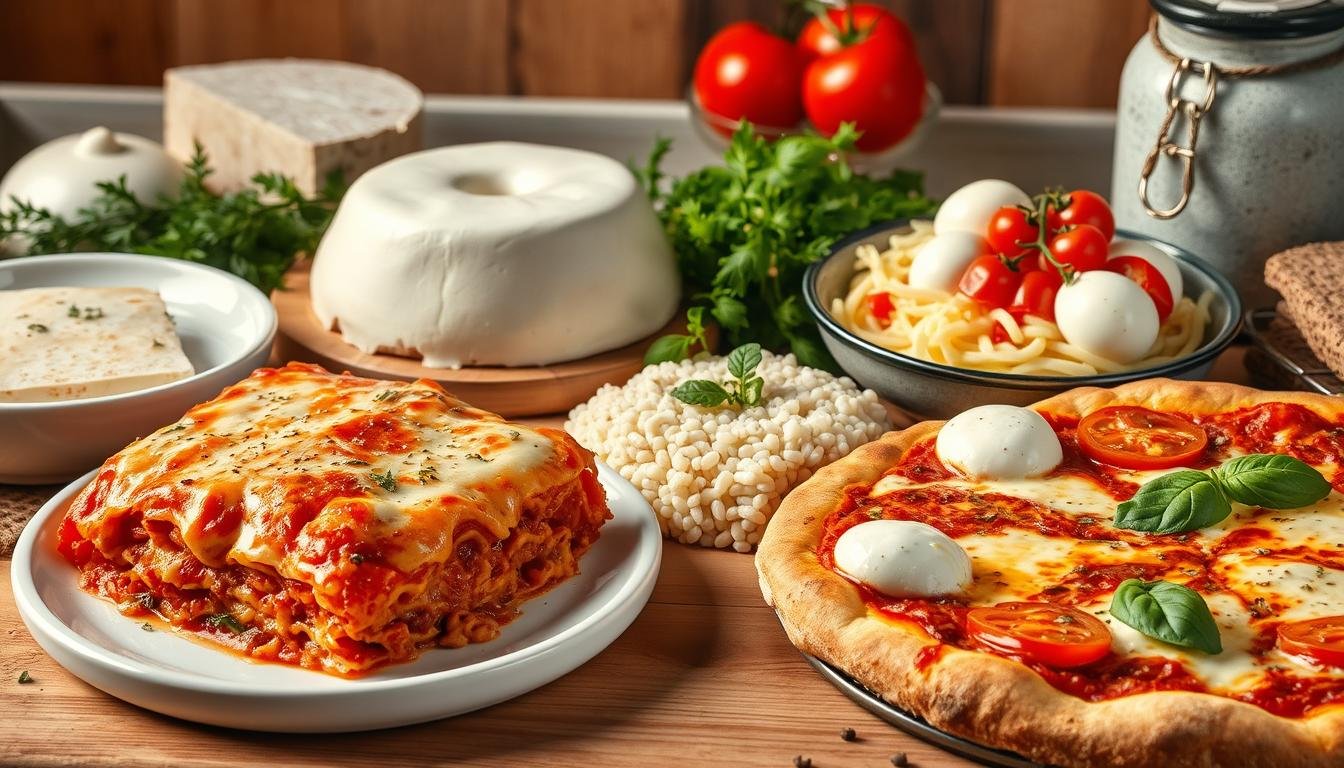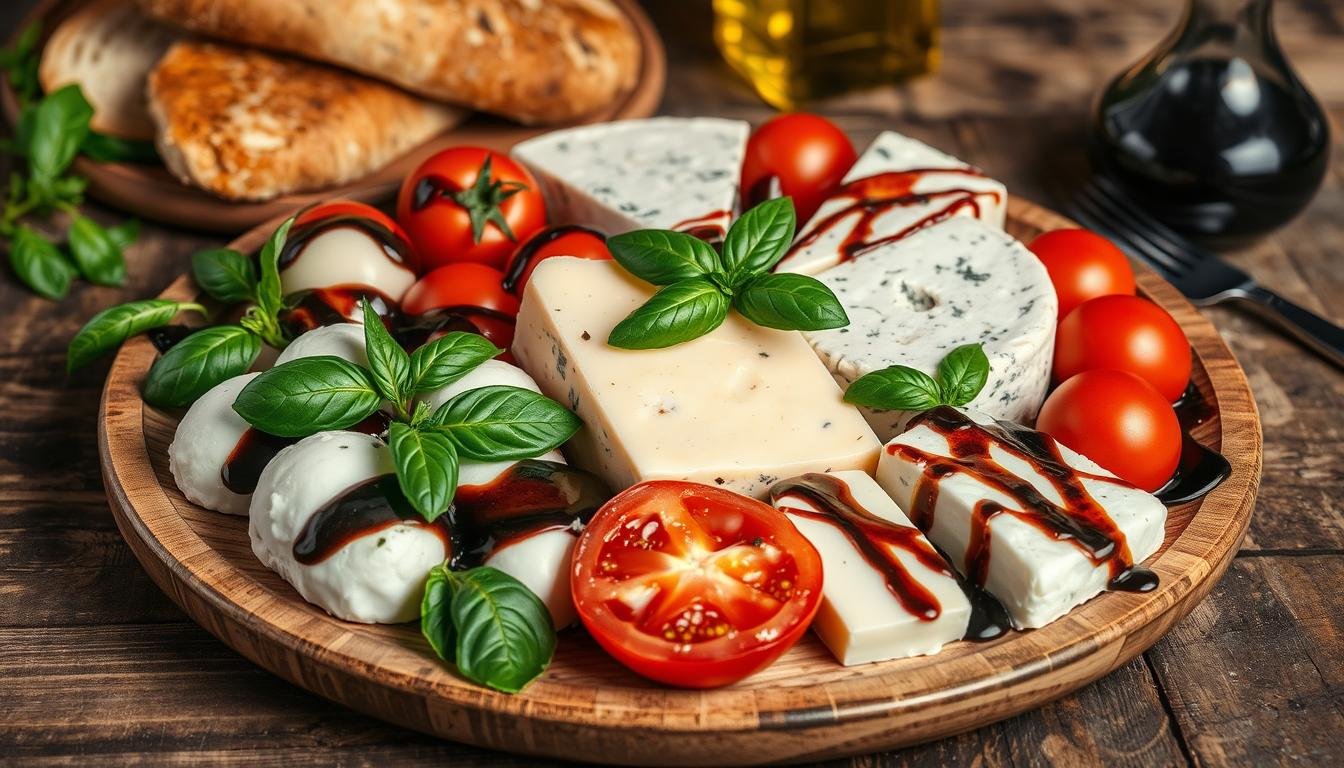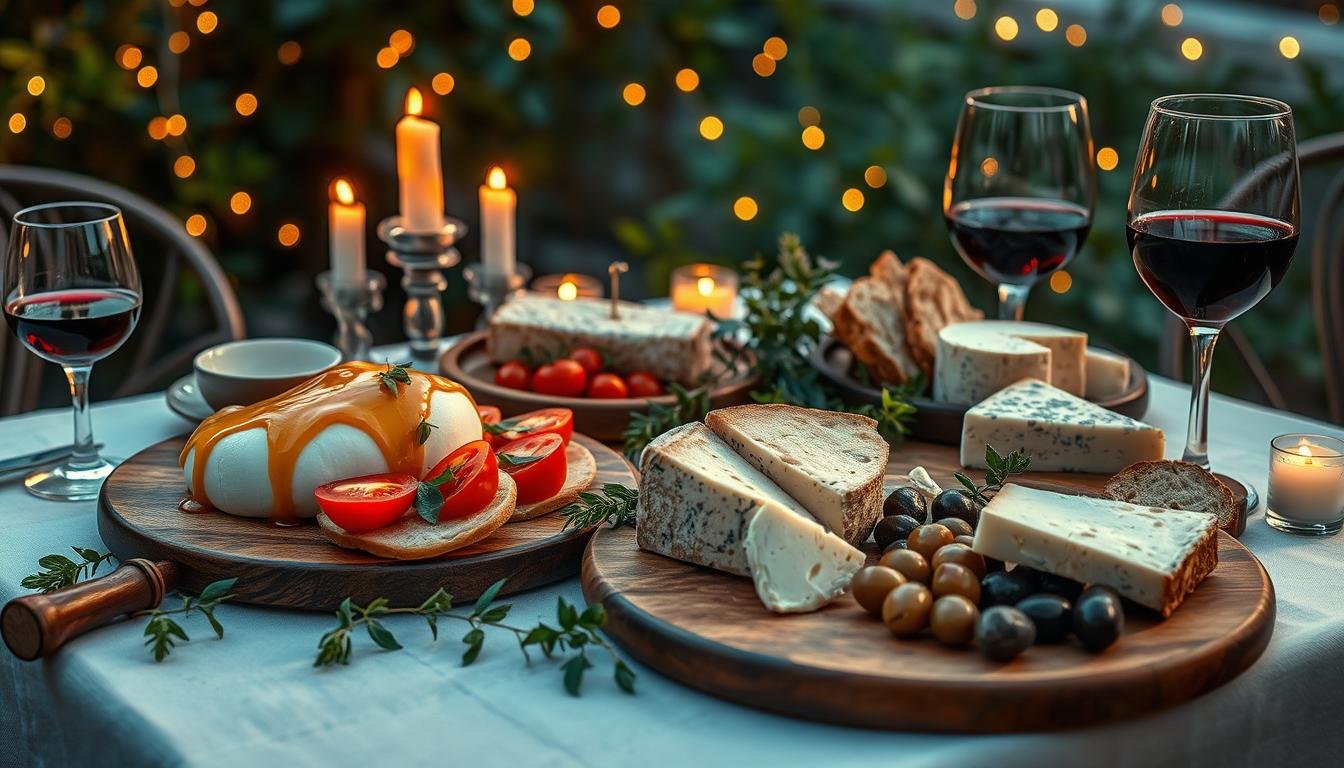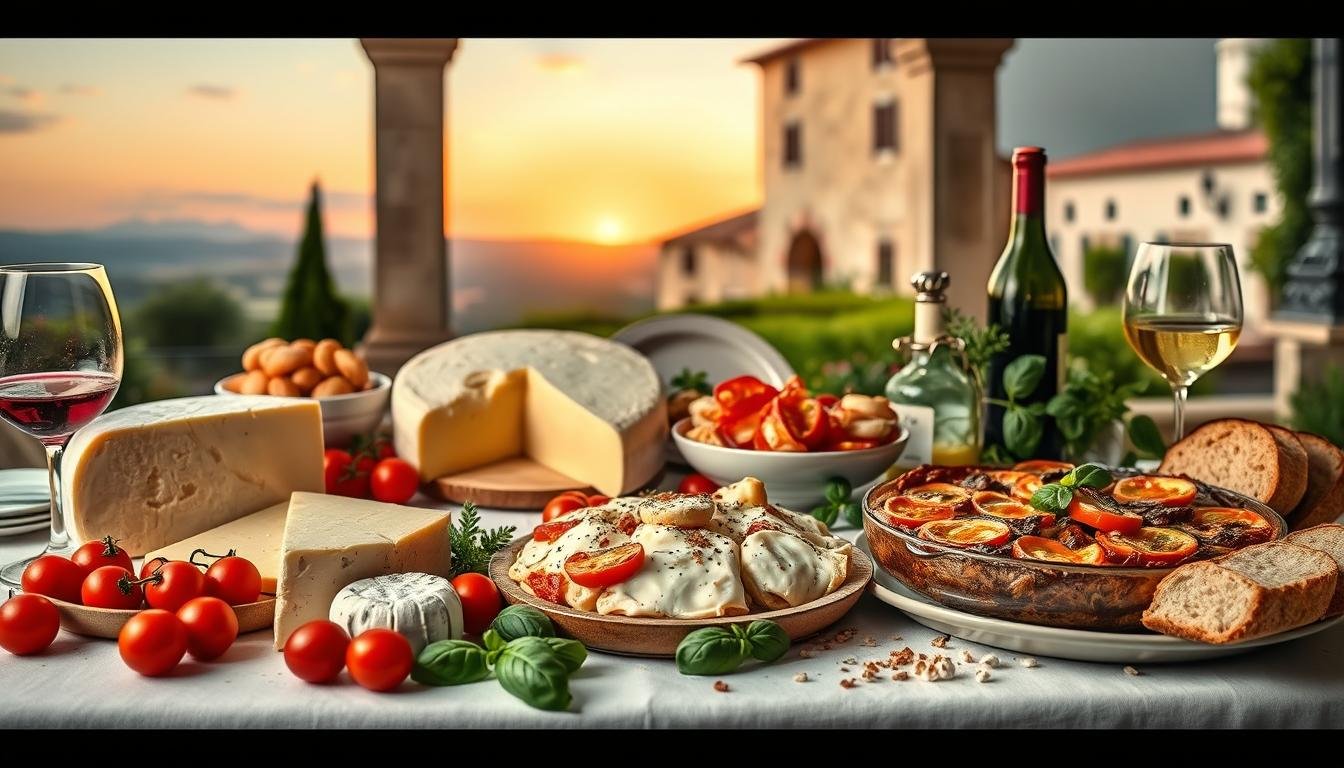Did you know Australians eat up to 80% more pork in autumn and early winter? This is because pigs were once slaughtered before refrigeration. Italian cuisine uses seasonal ingredients to make delicious meat dishes.
This guide will take you through Italy’s meat-based recipes. You’ll learn about dishes like osso buco and porchetta. By using seasonal ingredients, you can make meals that truly capture Italy’s culinary spirit.
Key Takeaways
- Discover the rich diversity of traditional Italian meat-based recipes
- Explore the importance of using fresh, seasonal ingredients in Italian cuisine
- Learn how to prepare classic Italian meat dishes like osso buco and porchetta
- Understand the regional variations and unique flavour profiles of Italian meat recipes
- Discover tips for sourcing quality meat and pairing it with the perfect seasonal accompaniments
Introduction to Seasonal Italian Cuisine
Italian food is famous for using fresh, seasonal ingredients. This method ensures the best taste and quality. Meat is a big part of many Italian dishes, with different areas having their own special tastes.
Importance of Seasonal Ingredients
In Italy, “cucina povera” (peasant cooking) is a key idea. It means making the most of what you have. Chefs love using top-quality, local ingredients. They say things like “Al contadino non far sapere quant’è buono il formaggio con le pere” (Don’t tell the farmer how good cheese is with pears).
Overview of Meat-Based Dishes
Italian meat dishes are varied and delicious. From Tagliatelle al Ragu in Bologna to grilled Arrosticini in Abruzzo, there’s something for everyone. Each region has its own special meat dishes, using the best Seasonal Ingredients. The history of Traditional Italian Cuisine goes back to the 4th century BC and has spread worldwide.
“The story of Italian cuisine dates back to around the 4th century BC, and it has evolved over time to become a global phenomenon.”
Autumn Flavours: Hearty Meats
As the weather cools and leaves change, Italian food becomes heartier and more comforting. Autumn in Italy is all about slow-cooked dishes. These dishes use the season’s best produce and meats.
Osso Buco: A Milanese Classic
Osso Buco is a Milanese dish loved in autumn. It’s braised veal shanks in a rich sauce. The meat becomes tender after slow cooking.
It’s cooked with veggies, white wine, and broth. A zesty gremolata of parsley, lemon zest, and garlic adds freshness.
Porchetta: Roasted Succulent Pork
Porchetta is a traditional Italian roast pork dish. A pork belly is seasoned, rolled, and slow-roasted. The result is a juicy, flavorful dish.
It’s great with roasted veggies or a tangy salad.
| Dish | Key Ingredients | Cooking Time | Recommended Serving |
|---|---|---|---|
| Osso Buco | Veal shanks, onions, carrots, celery, white wine, broth | 2-3 hours | Serve with gremolata and polenta or risotto |
| Porchetta | Pork belly, garlic, rosemary, fennel, salt, pepper | 3-4 hours | Slice and serve with roasted potatoes and seasonal greens |
These dishes highlight the use of seasonal ingredients and slow cooking. Osso Buco and Porchetta are perfect for autumn. They’re hearty and delicious with the season’s changes.
Winter Comfort Foods: Slow-Cooked Meats
As winter arrives, we all crave warm, comforting dishes. Italian cuisine offers just that with Beef Ragu and Cacciatore-style chicken. These dishes turn simple ingredients into amazing meals.
Beef Ragu: A Rich Sauce for Pasta
Beef Ragu is a classic Italian dish. It’s a slow-cooked meat sauce that makes pasta special in winter. It’s made with tender beef, herbs, and tomatoes.
This sauce is great with tagliatelle or pappardelle. It takes 360 minutes to prepare and has 139 to 766 calories per serving. It’s perfect for a cold night.
Cacciatore: Hunter-Style Chicken
Cacciatore, or “hunter-style” chicken, is a winter favourite. It’s made with tender chicken, tomato sauce, red wine, herbs, and olives. The slow cooking brings out rich flavours.
Chicken recipes, like Cacciatore, make up 20% of the recipes. They show how versatile and loved chicken is in comfort food.
These slow-cooked Italian meat-based recipes are perfect for winter. Whether you prefer Beef Ragu or Cacciatore, these winter recipes are the ultimate comfort foods.

Spring Delicacies: Fresh Produce and Meats
When spring arrives in Italy, the markets are filled with fresh produce. This is the ideal time for light, produce-focused dishes. A standout is Lamb with Spring Vegetables, combining tender meat with the season’s first harvests.
Preparing this dish is quick, taking about 45 minutes. The lamb roasts at 190 degrees for 30 minutes until it’s cooked. Spring veggies like fennel and courgettes are sautéed for 10 minutes, highlighting their fresh flavours.
Grilled Asparagus with Prosciutto
Grilled Asparagus with Prosciutto is another spring gem. It’s a simple yet tasty mix of cured meats and fresh veggies. Tuscany’s green asparagus is briefly boiled, then cooled before being wrapped in prosciutto.
The Involtini di Asparagi e Prosciutto dish is ready in 15-20 minutes. It bakes at 190 degrees until the cheese is golden. This recipe beautifully combines spring’s best in an Italian-inspired dish.
“The first fresh produce of the season always inspires me to create light, vibrant dishes that celebrate the flavours of spring.”
| Dish | Preparation Time | Cooking Time |
|---|---|---|
| Lamb with Spring Vegetables | 45 minutes | 30 minutes (lamb in oven at 190°C), 10 minutes (vegetables in pan) |
| Grilled Asparagus with Prosciutto | 15-20 minutes | 20-25 minutes (asparagus in oven at 190°C) |
Summer Specials: BBQ and Grilling
As the warm summer sun shines over Italy, the air is filled with the smells of sizzling meats and charred vegetables. This is the time of year when outdoor cooking and grilling are at their best. They showcase Italy’s love for seasonal, flavourful dishes. Two standout summer recipes are Salsiccia (Italian sausage) and Caprese Skewers with Grilled Steak.
Salsiccia: Italian Sausage on the Grill
No Italian Summer Recipes are complete without Salsiccia. These sausages come in many regional styles, each with its own unique flavours. Whether it’s the fennel-infused Luganega from Lombardy or the paprika-laced Ciauscolo from the Marche region, grilling them brings out their best.
To prepare the perfect grilled Salsiccia, prick the casings with a fork. This lets the juices escape. Then, brush the sausages with olive oil and season with salt, black pepper, and herbs. Grill them over high heat, turning them occasionally, until they’re beautifully charred and cooked through, about 10-15 minutes.
Caprese Skewers with Grilled Steak
For a refreshing Italian BBQ dish, try grilled Caprese Skewers. Juicy tomatoes, creamy mozzarella, and fragrant basil come together on skewers, paired with tender, grilled steak for a satisfying summer treat.
To make the Caprese Skewers, alternate bite-sized pieces of ripe tomatoes, fresh mozzarella, and fresh basil leaves on wooden skewers. Brush the skewers with olive oil and season with salt and pepper. Grill the skewers alongside your favourite cuts of grilled steak, such as ribeye or top sirloin, until the cheese is lightly charred and the meat is cooked to your desired doneness.
Embrace the flavours of an Italian BBQ this summer by indulging in these classic Summer Recipes – from the smoky-sweet Salsiccia to the fresh and vibrant Caprese Skewers with Grilled Steak. Gather your friends and family, fire up the grill, and enjoy the best of Italy’s warm-weather cuisine.

Regional Variations in Meat Recipes
Italy’s rich culinary landscape shows off its diverse regional traditions. The north is known for beefy dishes, while the south loves seafood. These regional meat recipes are a feast for the senses.
Northern Italian Specialties
In the north, like Piedmont and Lombardy, beef and pork are stars. Milan’s Osso Buco is a veal shank dish in a tomato sauce. Piedmont’s Bollito Misto is a mix of boiled meats, including beef, pork, and sausage.
Southern Italian Favourites
The south, like Sicily and Calabria, offers a mix of proteins. Sicilian Involtini are veal or beef rolls with breadcrumbs and herbs. Calabria’s ‘Nduja sausage adds spice to many dishes.
| Northern Italian Recipes | Southern Italian Dishes |
|---|---|
| Osso Buco (Braised Veal Shanks) | Sicilian Involtini (Stuffed Veal Rolls) |
| Bollito Misto (Boiled Meat Platter) | ‘Nduja (Spicy Calabrian Sausage) |
| Brasato al Barolo (Braised Beef in Barolo Wine) | Lamb with Spring Vegetables |
The variety in Regional Italian Cuisine highlights Italy’s rich food history. Each region adds its twist to classic Northern Italian Recipes and Southern Italian Dishes. From the north’s meaty dishes to the south’s seafood, Italy’s flavours amaze food lovers everywhere.
Exploring Game Meat Dishes
In Italy, game meats are a big deal, more so in rural areas. You’ll find dishes like Wild Boar Ragù from Tuscany and Rabbit with Olives and Capers in central and southern Italy. These dishes highlight Italy’s skill in making lean meats taste amazing.
Wild Boar Ragù: Traditional and Authentic
Renowned chef Silvia Baldini comes from Northern Italy’s mountains. She’s known for her regional dishes. Her background includes the Cordon Bleu in London and Michelin-starred restaurants.
Baldini loves Italian Game Meat. Her Wild Boar Ragù is a must-try. She recommends venison, a lean meat, for its health benefits.
In her roasted venison dish, she uses blueberries for a twist. Venison’s deep colour and taste are perfect for strong sauces and herbs.
Rabbit with Olives and Capers
Rabbit with Olives and Capers is loved in central and southern Italy. This lean meat pairs well with olives and capers. It’s a dish that brings out the best in Italian cuisine.
“Trying Wild Boar for the first time in a dish like Wild Boar Bolognese is highly recommended. The deep, rich flavour of the meat pairs beautifully with the robust Chianti wine, creating a truly authentic Italian experience.”
| Dish | Average Rating | Highest Rating | Lowest Rating |
|---|---|---|---|
| Wild Boar Ragù | 4.6 | 5 | 3 |
| Rabbit with Olives and Capers | 4.7 | 5 | 4 |

Exploring Italian Game Meat dishes is a journey for the adventurous. From Wild Boar Ragù to Rabbit with Olives and Capers, these recipes show Italy’s skill in cooking lean meats. They offer a taste of Italy’s rich culinary heritage.
Incorporating Seafood in Meat Dishes
Italian cuisine is known for mixing land and sea flavours. The Italian Surf and Turf is a perfect example. It combines grilled steak with garlic prawns or scallops. This mix offers a delightful mix of textures and tastes.
Seafood Risotto with Chorizo is another creative way to mix seafood with meat. It combines creamy risotto, spicy chorizo, and fresh seafood. This dish is a perfect blend of land and sea.
Surf and Turf: Italian-Style
To make a true Italian Surf and Turf, grill a thick steak first. Then, add sautéed garlic prawns or scallops. Finish with olive oil and fresh herbs for extra flavour.
Seafood Risotto with Chorizo
Try a Seafood Risotto with Chorizo for a modern twist. Start with a seafood stock made from clams, mussels, and clam juice. Cook the arborio rice slowly to get a creamy texture. Add chorizo, seafood, and cherry tomatoes for a fresh touch.

“The marriage of seafood and meat in Italian cuisine is a testament to the country’s culinary creativity and the versatility of its ingredients.”
Healthy Seasonal Options
Italian cuisine is full of healthy choices that show off the great taste of lean meats and good cooking methods. By using seasonal ingredients and careful cooking, you can make real Italian dishes that are both healthy and tasty.
Lean Cuts of Meat to Consider
For healthy Italian recipes, choose lean meats like chicken breast, turkey, and sirloin steak. These meats are rich in protein and taste great, making your meals healthy and low in fat. Using these lean meat cuts lets you enjoy your favourite healthy Italian recipes without harming your health goals.
Cooking Methods for Healthier Dishes
- Grilling: Adds a smoky flavour to meats without extra fats.
- Roasting: Highlights the natural sweetness of veggies and meats.
- Braising: Makes dishes tender by slow-cooking in a tasty liquid.
These healthy cooking methods keep your food’s nutrients while keeping the taste of Italian cuisine. By choosing seasonal produce and lean meat cuts, you can make healthy Italian recipes that are both tasty and healthy.
“Eating seasonal, local, and sustainable food is one of the best ways to support your health and the health of the planet.”

Traditional Italian Sauces for Meat
In Italian meat dishes, the sauce is often the main attraction. From tomato-based sauces to creamy delights, these sauces show the rich flavours of Italian cuisine.
Tomato Sauces for Every Season
Marinara, arrabbiata, and bolognese are popular tomato-based Italian Meat Sauces enjoyed all year. They start with ground beef or a mix of meats, then add red wine, garlic, and veggies. This mix simmers slowly to blend the flavours.
Creamy Sauces: A Comfort Addition
As winter comes, Creamy Italian Sauces like Alfredo or gorgonzola cream sauce add luxury to meat dishes. These sauces are rich and velvety, making meals comforting and satisfying. They offer a creamy, tangy contrast to the meat.
Italian sauces are perfect for any season. Whether you want a classic tomato ragù or a creamy sauce, these recipes will please your taste buds.

| Sauce Type | Key Ingredients | Serving Suggestions |
|---|---|---|
| Marinara | Tomatoes, garlic, olive oil, herbs | Pasta, meatballs, chicken parmesan |
| Arrabbiata | Tomatoes, garlic, chili peppers, olive oil | Penne, sausage, grilled vegetables |
| Bolognese | Ground beef, pork, onions, carrots, red wine | Tagliatelle, lasagna, eggplant parmesan |
| Alfredo | Butter, heavy cream, Parmesan cheese | Fettuccine, chicken, broccoli |
| Gorgonzola Cream | Gorgonzola cheese, heavy cream, garlic | Pappardelle, steak, roasted vegetables |
Pairing Side Dishes with Meat-Based Meals
In Italian cuisine, pairing side dishes with meat is key. It’s about balance and harmony. From Italian Side Dishes to Vegetable Pairings, these add to the meal’s flavour and beauty.
Classic Italian Sides and Salads
Pasta is a favourite that goes well with meat. Risotto adds creaminess and flavour. For a light touch, try Italian Salads like Caprese or Tricolore.
- Roasted potatoes with herbs and Parmesan
- Grilled or sautéed seasonal vegetables
- Pasta, such as penne or spaghetti, tossed with simple tomato or pesto sauces
- Creamy risotto alla Milanese with saffron
- Crisp Caprese salad with tomatoes, burrata, and basil
- Refreshing Tricolore salad with arugula, radicchio, and grapefruit
Seasonal Vegetable Pairings
Italian cuisine loves seasonal produce. In spring, try asparagus or peas and prosciutto. Summer brings grilled eggplant or stuffed tomatoes. As it cools, pumpkin or cipolline onions in agrodolce are perfect.
- Roasted asparagus with lemon and Parmesan
- Sweet peas with salty prosciutto
- Grilled eggplant with balsamic, basil, and capers
- Stuffed tomatoes with breadcrumbs, garlic, and herbs
- Roasted pumpkin with sage and pine nuts
- Cipolline onions in agrodolce (sweet and sour)
Using seasonal produce and Italian Side Dishes makes meals balanced and tasty. It highlights the best of Italian cooking.

Wine Pairings for Italian Meat Dishes
Italian cuisine shines when paired with the right Italian wines. From Tuscany’s bold reds to Alto-Adige’s crisp whites, Italy’s wine regions offer many choices. These wines enhance the taste of your Italian meat dishes throughout the seasons.
Regional Wines to Complement Flavours
Tuscany’s Sangiovese-based wines like Chianti and Brunello di Montalcino are perfect for meat dishes. Abruzzi’s Montepulciano d’Abbruzzo is great with grilled lamb and braised pork. Sicilian reds, such as Nero d’Avola, pair well with Mediterranean-inspired meats.
Campania’s Taurasi and Falerno del Massico, made from Aglianico, are versatile. Piedmont’s Nebbiolo-based Barolo and Barbaresco are bold, perfect for rich, slow-cooked dishes.
Pairing Tips for Each Season
In summer, light rosés or Pinot Grigio are great with grilled meats. As it cools, switch to fuller-bodied reds like Chianti for stews and braises.
For seafood, try chilled Verdicchio or Trebbiano d’Abruzzo. Barbera d’Alba or Fiano di Avellino are good with cured meats. Exploring regional Italian wines can greatly enhance your dining experience with Italian meat dishes.

| Region | Notable Wines | Recommended Pairings |
|---|---|---|
| Tuscany | Chianti, Brunello di Montalcino, Vino Nobile di Montepulciano | Hearty meat dishes, tomato-based sauces, pasta |
| Abruzzi | Montepulciano d’Abbruzzo | Grilled lamb, lasagna, braised pork |
| Sicily | Nero d’Avola, Nerello Mascalese | Mediterranean-inspired meat dishes |
| Campania | Taurasi, Falerno del Massico | Versatile pairing for a range of meat dishes |
| Piedmont | Barolo, Barbaresco | Rich, slow-cooked meat dishes |
Preparing Italian Meats at Home
Cooking Italian meat dishes at home might seem hard, but it’s easy with the right skills and tools. You can make dishes like Osso Buco or try new recipes. Learning a few key skills will make you a pro at cooking Italian food.
Essential Techniques for Home Cooks
There are a few main cooking techniques for Italian meat dishes. Braising makes meat tender and full of flavour. Sautéing quickly browns meats, adding rich flavours. Slow-cooking is key for hearty dishes.
Cooking Equipment You Should Have
You’ll need some basic kitchen tools to cook Italian meat dishes. A good Dutch oven is great for braising and simmering sauces. A strong pasta pot is useful for boiling pasta. A meat thermometer ensures your meat is cooked just right.
With these techniques and tools, you’re ready to cook delicious Italian meat dishes at home. Don’t be shy to try new things and enjoy the tastes of Italy. Your taste buds and family will love it!

| Cooking Technique | Description | Ideal for |
|---|---|---|
| Braising | Slowly cooking meat in liquid at a low temperature | Osso Buco, Beef Ragu |
| Sautéing | Quickly cooking meat in a hot pan to develop flavour | Chicken Cacciatore, Grilled Steak |
| Slow-Cooking | Cooking meat at a low temperature over an extended period | Beef Braciole, Pork Ragu |
With practice and the right equipment, you can become a master of Italian cooking at home. Buon appetito!
Tips for Finding Quality Meat
When making authentic Italian dishes, getting the right meat is key. In Australia, you can find many top-notch meat suppliers for Italian cuts. Working with a trusted local butcher is crucial for getting the perfect cuts for your dishes.
Sourcing Locally in Australia
Search for specialty Italian butchers or high-end supermarkets with a wide meat selection. These places often get their meat from trusted Australian suppliers, ensuring it’s fresh and of high quality. Learn about Italian meat cuts like osso buco (veal shanks) and bistecca alla fiorentina (thick T-bone steak) to order them correctly.
Understanding Cuts and Their Uses
It’s important to know the different Italian meat cuts and their Australian equivalents. For instance, osso buco is veal shanks, and bistecca alla fiorentina needs a thick T-bone steak. Also, learn about Italian cured and smoked pork products like capocollo, soppressata, and prosciutto and their Australian versions.
By understanding Italian meat cuts and building a good relationship with a local butcher, you can make your Italian dishes with the best ingredients. This will enhance your dining experience.
“Sourcing quality meat is the foundation for creating authentic Italian dishes. A good relationship with a local butcher can make all the difference in the world.”
Conclusion: Embracing Seasonal Cooking
Seasonal Italian meat-based recipes bring many benefits. You get fresher ingredients, better flavours, and a closer bond with traditional cooking. By following the Italian way, Australian home cooks can make diverse, healthy meals that change with the seasons. This journey not only improves your cooking but also deepens your understanding of Italian culture and traditions.
The Benefits of Cooking Seasonal Italian Meat Dishes
Cooking with seasonal Italian meat dishes lets you truly enjoy Italian cuisine. Ingredients like autumn’s osso buco or summer’s grilled salsiccia highlight the natural tastes and textures of Italian food. This approach also supports local farmers and is good for the planet, matching Evo Italian Food’s values.
Final Thoughts on Your Culinary Journey
Start your Italian cooking adventure by following the seasons. Discover different regions in Italy and find new ways to use meat in your cooking. From a hearty beef ragu to a simple grilled steak with fresh veggies, each dish will take you to Italy’s heart. You’ll gain a new respect for the art of cooking with the seasons.





